نمونه سوالات ریدینگ آیلتس با جواب — کلیدی ترین و کاربردی ترین سوال ها
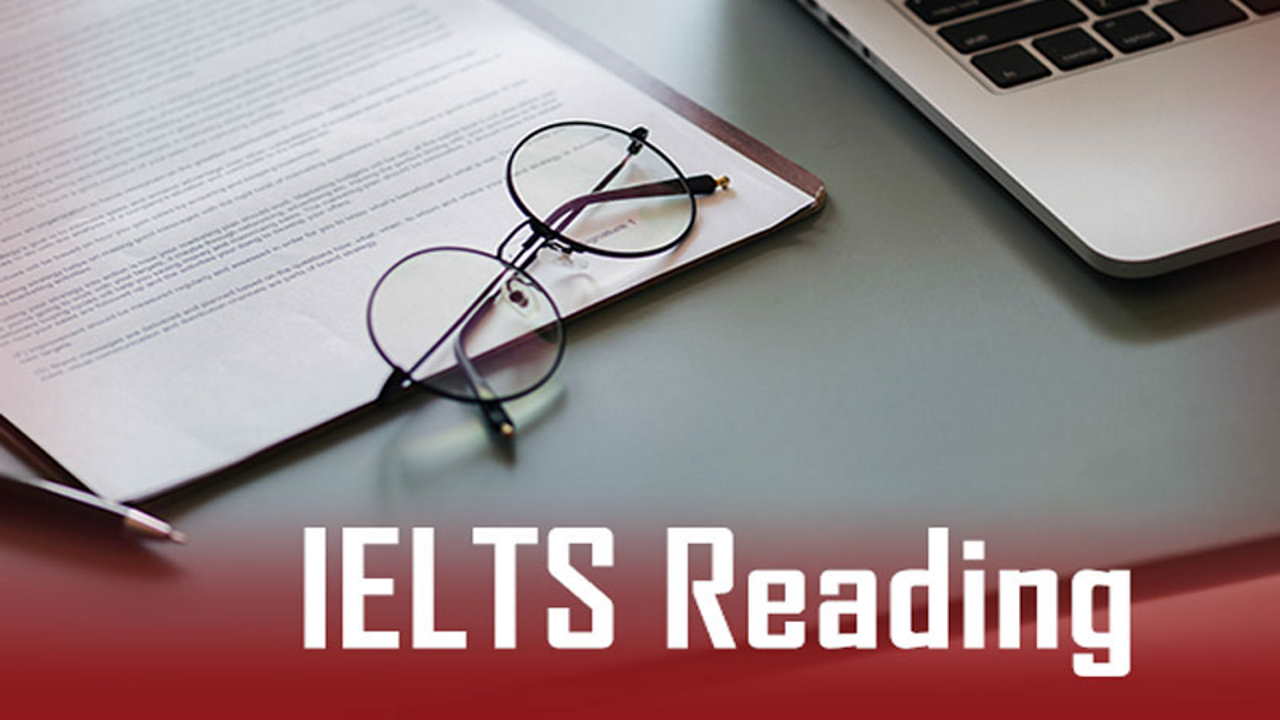
آزمون آیلتس یکی از آزمونهای بینالمللی معتبر است که در بسیاری از کشورهای دنیا برگزار میشود. این آزمون از چهار بخش تشکیل شده و هدف آن ارزیابی مهارتهای زبانی افراد است. یکی از بخشهای این آزمون «reading» است که شامل متنهایی به همراه پرسشهایی است که داوطلب باید به آنها پاسخ دهد. برای این کار لازم است با انواع سوالات ریدینگ آیلتس آشنا شویم و نمونه آزمونهای سالهای قبل را با جواب تمرین کنیم.
ساختار ریدینگ آزمون آیلتس
آزمون آیلتس از چهار بخش زیر تشکیل شده است:
- «Listening»
- «Reading»
- «Writing»
- «Speaking»
بخش اول به صورت کتبی و همه در یک روز و بدون وقفه برگزار میشود. بخش آخر «اسپیکینگ»، در حضور شخص مصاحبهکننده برگزار میشود که به صورت شفاهی است و ممکن است همان روز، قبل یا بعد از آزمون کتبی باشد یا یک هفته بعد از آزمون گرفته شود. این امر به مرکز برگزاری آزمون بستگی دارد. بخش دوم «ریدینگ» است که شامل سه قسمت میشود. هر یک از قسمتها از یک یا چند متن (با توجه به نوع آزمون آکادمیک یا جنرال) تشکیل شده که در انتهای هر متن، تعدادی سوال قرار داده شده است و داوطلب باید با توجه به متن به آنها پاسخ دهد.
نکته مهم در رابطه با ریدینگ آزمون آیلتس به نوع سوالها مربوط میشود. بخش ریدینگ حدود ۱۲ نوع سوال مختلف دارد که در روز آزمون با تعداد زیادی از آنها مواجه میشویم. برای اینکه بتوانیم پاسخ هر یک از سوالها را در متن پیدا کنیم، خواندن کل متن نهتنها نمیتواند کمکی به ما بکند، بلکه باعث میشود وقت زیادی را از دست بدهیم و در نهایت نتوانیم به همه بخشها پاسخ دهیم.
به منظور رفع این مشکل، بهتر است بدانیم انواع سوالهای ریدینگ آیلتس کدامند و چگونه باید به آنها پاسخ دهیم. به بیان سادهتر، باید ابتدا با تکنیکهای پاسخ دادن به سوالات بخش ریدینگ آشنایی کامل پیدا کنیم تا در مرحله بعد بتوانیم نمونه سوالات ریدینگ آیلتس را تمرین کنیم. انواع سوالات ریدینگ آیلتس برای ازمون آکادمیک و جنرال یکسان است، اما نوع آزمون و شیوه نمرهدهی، کمی تفاوت دارد. به همین دلیل در ادامه سعی کردهایم ساختار هر یک را شرح دهیم.
ریدینگ آیلتس آکادمیک
آزمون آیلتس به دو صورت «آکادمیک» (Academic) و «جنرال» (General) برگزار میشود. هر یک از آزمونها از سه بخش تشکیل شده که در مجموع ۴۰ سوال دارد. سوالها نمره منفی ندارد و مدت زمان پاسخگویی به آنها در مجموع یک ساعت است. بخش آکادمیک از سه متن بلند تشکیل شده و برای هر یک از متنها تعدادی سوال در نظر گرفته شده است که در مدت زمان تعیین شده باید به آنها پاسخ داده شود. متنها کاملاً آکادمیک هستند و از بخشهایی از روزنامه، مقاله یا مجلههای علمی انتخاب شدهاند. برای درک بهتر میتوانید نمونهای از ریدینگ آیلتس آکادمیک را در تصویر زیر مشاهده کنید که مربوط به یکی از آزمونهای سالهای قبل است.
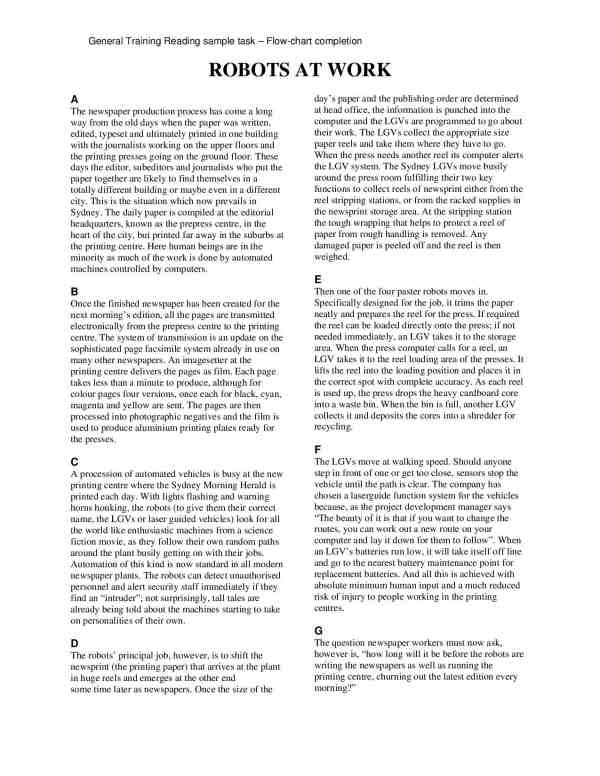
ریدینگ آیلتس جنرال
آیلتس جنرال، برخلاف آیلتس آکادمیک از دو یا چند متن کوتاه برای بخشهای اول دوم تشکیل شده است. بخش اول دو یا سه متن کوتاه درباره موضوعاتی واقعی است. بخش دوم به موضوعات کاری مربوط میشود و بخش سوم شامل متنی بلند و تخصصی مانند آیلتس آکادمیک است. برای پاسخ دادن به سوالات هر بخش، به طور میانگین ۲۰ دقیقه در نظر گرفته شده است، اما چون متن سوم طولانیتر و سختتر است، توصیه میشود مدت زمان بیشتری را به آن اختصاص دهید. برای آشنایی بیشتر با نمونه سوالات ریدینگ آیلتس جنرال، میتوانید تصویری از آزمون سالهای قبل را مشاهده کنید.
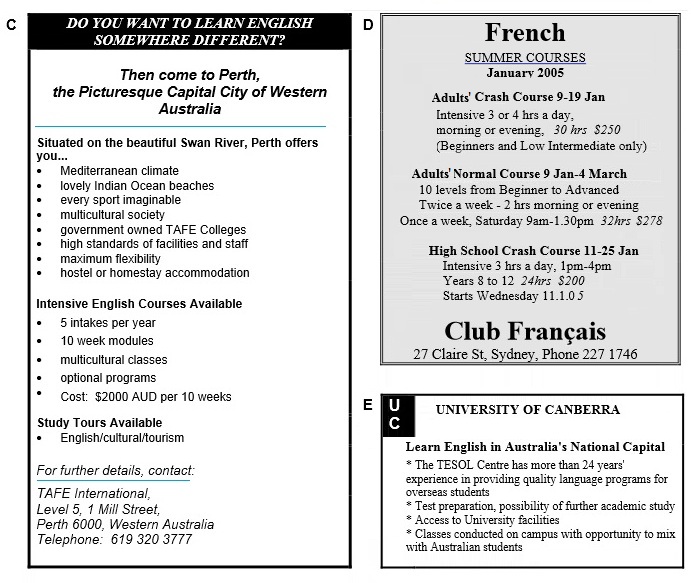
نمونه سوالات ریدینگ آیلتس
آزمون ریدینگ آیلتس از سوالهای مختلفی تشکیل شده است. به طور کلی این سوالها را در ۱۲ دستهبندی قرار میدهند و بسیاری از منابع آموزشی بر این نکته تأکید دارند که برای تسلط بر سوالات این بخش لازم است با انواع سوالها و نحوه پاسخدهی به آنها به طور کامل آشنایی داشته باشیم. در غیر این صورت، هر چقدر هم که تست بزنیم و نمونه سوالات ریدینگ آیلتس را تمرین کنیم، تأثیر چندانی در نتیجه کلی نخواهد داشت.
در این آموزش قصد داریم نمونه سوالات ریدینگ آیلتس را با جواب معرفی کنیم، اما قبل از آن توضیحات کاملی در رابطه با انواع سوالات ریدینگ آیلتس ارائه خواهیم کرد و به کمک مثالهایی از آزمونهای آیلتس سالهای قبل، توضیحات خود را تکمیل میکنیم. در ادامه نمونه سوالات را با پاسخ قرار میدهیم تا بتوانید با آمادگی کامل به سراغ آنها بروید و عملکرد خود را بررسی کنید.

انواع سوالات ریدینگ آیلتس
آزمون ریدینگ آیلتس (آکادمیک و جنرال)، از ۱۲ نوع سوال مختلف تشکیل شده است که در ادامه آنها را بررسی خواهیم کرد. این دستهبندی شامل موارد زیر میشود:
- سوالات Matching Headings
- سوالات Multiple Choice
- سوالات Short Answer
- سوالات Name Matching
- سوالات True/False/Not Given
- سوالات Yes/No/Not Given
- سوالات Summary Completion
- سوالات Matching Sentence Endings
- سوالات Sentence Completion
- سوالات Matching Paragraph Information
- سوالات Table Completion
- سوالات Diagram Labelling
سوالات Matching Headings
در این نوع سوالها، با چند عنوان که به آنها «heading» گفته میشود مواجه میشوید که باید به پاراگرافهای متن وصل کنید. یعنی باید در نظر بگیرید که کدام هدینگ برای کدام پاراگراف مناسب است. برای پاسخ دادن به این نوع سوالها دو راهکار وجود دارد:
- اول متن را بخوانید، سپس «heading» را بخوانید.
- اول «heading» را بخوانید و سپس در متن به دنبال آنها بگردید.
برخی از اساتید راه اول را پیشنهاد میکنند و برخی راه دوم را. اما ممکن است هنگام پاسخ دادن به این نوع سوالها با مشکلاتی مواجه شوید، مانند موارد زیر:
- تعداد «heading» بیشتر از پاراگرافهای متن است. این مسئله باعث میشود پیدا کردن جواب درست کمی دشوارتر شود.
- برخی از هدینگها از نظر معنی خیلی به هم شبیهاند.
- احتمال اشتباه گرفتن جزئیات در یک پاراگراف با ایده محوری زیاد است. اما ممکن است با هم تفاوت داشته باشند.
- مترادفها و پارافریزها اغلب استفاده میشود.
- به راحتی میتواند وقت زیادی از داوطلب بگیرد و به همین راحتی فرصت پاسخ دادن به سوالهای دیگر را از دست بدهد.
راهکارهایی برای پاسخ دادن به این نوع سوالها وجود دارد که در ادامه تعدادی از آنها را معرفی کردهایم. این مراحل را باید بهترتیب تمرین کنید.
- عنوانها را بخوانید.
- زیر کلمههای کلیدی خط بکشید.
- عنوانهای مشابه را پیدا کنید.
- پاراگراف اول را بخوانید.
- هدینگ مناسب را برای آن انتخاب کنید.
- اگر نتوانستید هدینگ را پیدا کنید، وقت خود را بیشتر از این صرف نکنید و به سراغ سوالات بعدی بروید.
- این کار را برای همه هدینگها تکرار کنید.
در تصویر زیر نمونهای از سوالات «Matching Headings» را مشاهده میکنید.

سوالات Multiple Choice
در این نوع سوالها، با دو، سه، چهار یا حتی بیشتر از چهار گزینه مواجه میشویم که از بین آنها باید گزینه درست را برای سوال مربوطه پیدا کنیم. البته در برخی موارد ممکن است بیش از یک گزینه درست وجود داشته باشد که صورت سوال به آن اشاره خواهد کرد. برای پاسخ دادن به سوالات «Multiple Choice» بهتر است مراحل زیر را بهترتیب تمرین کنید.
- ابتدا سوال را با دقت بخوانید.
- پاسخها در متن بهترتیب است.
- آن قسمت از متن که کلمههای مترادف در صورت سوال را در آن پیدا کردید، با دقت بخوانید.
- دوباره آن پاراگراف را بخوانید و به دنبال پاسخ سوال باشید.
- به دنبال کلمههایی باشید که ممکن است شما را از موضوع اصلی منحرف کنند.
- هیچ پاسخی را بیجواب نگذارید. زیرا آزمون آیلتس نمره منفی ندارد.
در تصویر زیر نمونهای از سوالات «Multiple Choice» را مشاهده میکنید.


سوالات Short Answer
در این نوع سوالها، داوطلب با تعدادی سوال مواجه میشود که باید به آنها پاسخ کوتاه بدهد. در دستورالعمل سوال به تعداد کلمههای مجاز برای پاسخ دادن به سوالها اشاره شده است، بنابراین، باید آن را مدنظر داشته باشیم. برای پاسخ دادن به سوالات «Short Answer» باید نکات زیر را رعایت کنیم.
- ابتدا سوال را با دقت بخوانید، سپس کلمههای کلیدی آن را مشخص کنید.
- پاسخها در متن بهترتیب است.
- بیشتر از تعداد کلمههایی که برای پاسخ به هر سوال در نظر گرفته شده ننویسید.
- پاسخ سوالات را با کلمههای خودتان ننویسید. فقط از کلمههای داخل متن استفاده کنید و عیناً وارد برگه پاسخنامه کنید.
- بیشتر سوالها شامل کلمههای کلیدی هستند که مترادف یا پارافریز آنها در متن پیدا میشود. پس به دنبال پیدا کردن عین کلمههای کلیدی در متن نباشید، زیرا فقط وقت خود را هدر میدهید.
- فراموش نکنید که قبل از خواندن صورت سوال از تکنیک «Skimming» هم کمک بگیرید. بدین صورت که متن را سریع بخوانید و سعی کنید مفهوم کلی را درک کنید. همچنین اسم خاص مانند افراد یا نام مکان و تاریخها را نیز موقع خواندن سریع متن در نظر داشته باشید، زیرا وقتی به سراغ صورت سوال میروید، این کلمهها در ذهنتان میماند و با دیدن آنها در صورت سوال، راحتتر میتوانید در متن آنها را بیابید.
- این مراحل را بهترتیب برای تکتک سوالهای «Short Answer» تکرار کنید.
در تصویر زیر میتوانید نمونهای از سوالهای «Short Answer» را مشاهده کنید.
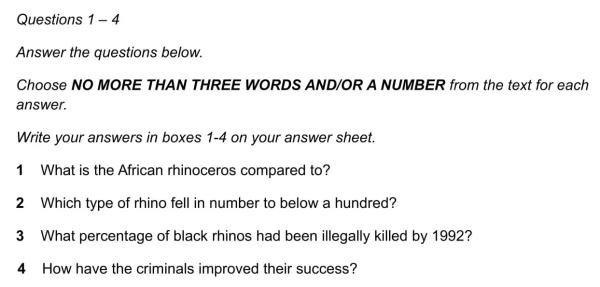
سوالات Name Matching
در این نوع سوالها، باید فهرستی از اسمهایی که در صورت سوال آمده را به فهرستی از اطلاعات موجود در متن وصل کنید. برای این کار لازم است نکات زیر را در نظر داشته باشید تا بتوانید به سوالها به درستی پاسخ دهید.
- در این نوع نمونه سوالات ریدینگ آیلتس جملهها بهترتیب در متن ظاهر نمیشوند. هیچیک از اسمها نیز به ترتیبی که فهرست شدهاند، در متن وجود ندارند.
- برخی از اسمها ممکن است در متن به صورت نام یا نام خانوادگی مخفف نوشته شده باشند، یا فقط نام یا نام خانوادگی آنها به کار رفته باشد. برای مثال «Gregor Borek» ممکن است به صورت «G. Borek» یا «Borek» در متن نوشته شده باشد.
- میتوانیم از رنگهای مختلفی برای خط کشیدن زیر کلمههای کلیدی استفاده کنیم.
- وقت زیادی را صرف پاسخ دادن به هر سوال نکنید. اگر نتوانستید جواب یکی از آنها را پیدا کنید، به سراغ بعدی بروید. وقتی گزینههای دیگر حذف میشوند، راحتتر میتوان پاسخ سوال سختتر را پیدا کرد.
برای پاسخ دادن به سوالهای «Name Matching» مراحل زیر را به ترتیب انجام دهید.
- با دقت جملهها را بخوانید و مفهوم آنها را درک کنید. اگر متوجه نشدید، وقت زیادی را صرف آن نکنید.
- متن را «skim» کنید و زیر اسمهای خاص خط بکشید. این کار را قبل از خواندن متن انجام دهید. اگر روی کلمههایی تمرکز کنید که با حرف بزرگ نوشته شدهاند، بهتر میتوانید آنها را در متن پیدا کنید.
- اسمهایی به عنوان پاسخ سادهتر در نظر گرفته میشوند که فقط یک بار در متن تکرار شده باشند. پس اول به سراغ پاسخ دادن به این نوع سوالها بروید. این کار باعث میشود که کار برای پیدا کردن پاسخ سوالهای دشوارتر، آسانتر شود.
- معمولاً نظرات، یافتهها یا نظریه شخص ممکن است یا قبل یا بعد از اسم بیاید، به همین دلیل جمله قبل و بعد از اسم را نیز بخوانید.
- با دقت جزئیات مربوط به نظرات، یافتهها و نظریهها را بخوانید و به دنبال مترادفهایی باشید که ممکن است در وصل کردن سوال به پاسخ آن به شما کمک کند.
- به سراغ فهرست جملهها بروید و آنها را به اسمها وصل کنید. سپس پاسخ خود را از میان اسمها پیدا کنید.
در تصویر زیر نمونه سوالات ریدینگ آیلتس مربوط به «Name Matching» را مشاهده میکنید.

سوالات True/False/Not Given
در این نوع نمونه سوالات ریدینگ آیلتس جملههایی به عنوان سوال مطرح میشود که داوطلب باید آنها را بخواند و در نهایت تشخیص دهد که با توجه به اطلاعات موجود در متن، جمله درست یا نادرست است یا اطلاعات آن در متن وجود ندارد. هنگام پاسخ دادن به این نوع سوالها باید سه حالت زیر را مدنظر داشته باشیم:
- اگر اطلاعات سوال با اطلاعات موجود در متن مطابقت داشته باشد، پاسخ آن «True» است.
- اگر اطلاعات سوال برخلاف اطلاعات موجود در متن باشد، پاسخ آن «False» است.
- اگر هیچ اطلاعاتی از صورت سوال در متن وجود نداشته باشد، پاسخ «Not Given» است.
برای پاسخ دادن به سوالات «True/False/Not Given» بهتر است نکات زیر را رعایت کنید.
- پاسخها به ترتیب در متن ظاهر میشوند.
- نباید کل متن را بخوانید. اول باید کلمههای کلیدی را در صورت سوال پیدا کنید و سپس به دنبال مترادف یا پارافریز آنها در متن بگردید. سپس آن قسمت از متن را با دقت بخوانید تا در نهایت بتوانید پاسخ درست را پیدا کنید.
- از هر سه گزینه دستکم یک بار به عنوان پاسخ سوال استفاده شده است. بنابراین، اگر کل سوالها را پاسخ دادید و متوجه شدید که از یکی از گزینههای «True»، «false» یا «Not Given» استفاده نکردهاید، بدون شک یک جای کار را اشتباه کردهاید.
- مراقب کلمهها یا عنوانهای گمراهکننده باشید. این کلمهها را بهعمد در متن قرار میدهند تا شما را گمراه کنند و پاسخ اشتباه را انتخاب کنید. برخی از این کلمهها در جدول زیر آمده است. هنگام پاسخ دادن به این نوع سوالها باید مراقب باشید که با دقت این نوع کلمهها را بخوانید و با در نظر گرفتن آنها به سوالها پاسخ دهید.
|
«کلمههای انحرافی» Distractors | ||
| most | always | every |
| occasionally | some | a few |
| often | all | |
استفاده از این نوع کلمهها در جمله میتواند بهکل معنی آنها را عوض کند. مثال زیر را در نظر بگیرید.
E.g. Tiantian often meets up with her friends after work.
Tiantian occasionally meets up with her friends after work.
کلمههای دیگری نیز وجود دارند که برای بیان احتمال به کار میروند. تعدادی از آنها در جدول زیر فهرست شده است.
| کلمههایی که برای بیان شک و تردید به کار میروند | |
| possibly | seem |
| believe | claim |
| probably | suggest |
حضور این کلمهها نیز میتواند در مفهوم کلی جمله تغییر ایجاد کند، مانند تفاوت بین دو مثال زیر:
E.g. Scientists now claim that several different species of humans evolved on the earth.
Scientists now know that several different species of humans evolved on the earth.
- به دنبال عین کلمههای موجود در صورت سوال نباشید. بلکه باید مترادف یا پارافریز آنها را در متن پیدا کنید. در واقع معنی کلمههاست که شما را به پاسخ سوال میرساند، نه خود کلمههای کلیدی.
- این آزمون وسیلهای برای ارزیابی دانش و آگاهی شما از موضوع نیست، بلکه روشی برای سنجش مهارت خواندن و درک مطلب است. در واقع، فقط باید با خواندن اطلاعات موجود در متن به سوالهای مربوط به آن پاسخ دهید. بنابراین، اگر با متنی مواجه شدید که از قبل اطلاعاتی درباره موضوع آن داشتید، دانستههای خود را فراموش کنید و فقط روی اطلاعات متن تمرکز کنید. همچنین اگر هیچ اطلاعاتی درباره موضوع نداشتید، نگران نشوید، زیرا نیازی به دانش و آگاهی قبلی شما برای پاسخ دادن به سوالها نیست.
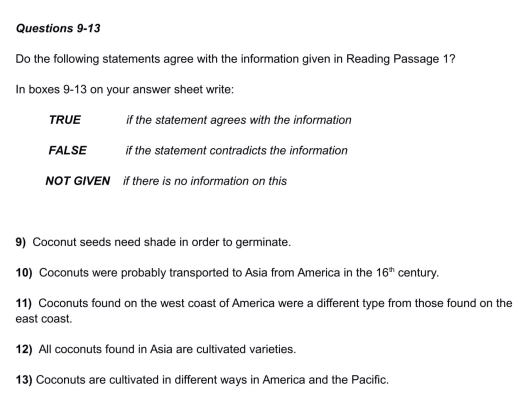
سوالات Yes/No/Not Given
برای پاسخ دادن به این نوع سوالها نیز باید بتوانید اطلاعات موجود در صورت سوال را با اطلاعات موجود در متن تطبیق دهید. برای این کار، باید این نکته را در نظر داشته باشید که وقتی اطلاعاتی در متن وجود ندارد، گزینه نادرست نیست بلکه باید «Not Given» را به عنوان پاسخ صحیح انتخاب کنید. این همان چالشی است که بیشتر داوطلبان با آن مواجهند.
دومین چالشی که در رابطه با سوالهای «True/False/Not Given» نیز مطرح شد، این است که داوطلب در متن به دنبال عین کلمههای کلیدی موجود در صورت سوال میگردد، درحالیکه باید مترادف آنها را پیدا کند. با این کار نه به جواب میرسد و نه میتواند در بازه زمانی مشخص شده به همه سوالها پاسخ دهد.
در نهایت، چیزی که باعث میشود داوطلب با چالش بیشتری مواجه شود این است که «true/false» را بهجای «yes/no» به کار میبرد یا برعکس. با این کار، حتی اگر پاسخ درستی داده باشد، به عنوان پاسخ اشتباه در نظر گرفته میشود و نمره آن را سوال را از دست خواهد داد.
بنابراین، هنگام پاسخ دادن به این نوع نمونه سوالات ریدینگ آیلتس باید مراقب باشیم که بیجهت نمره را از دست ندهیم. در ادامه، به راهکارهایی در زمینه پاسخ دادن به سوالهای این بخش اشاره کردهایم.
در رابطه با این نوع سوالها نیز باید مراقب گزینههای انحرافی باشیم که به آنها «distarctor» گفته میشود. در بخش توضیحات مربوط به سوالات «True/False/Not Given» به تعدادی از این کلمهها اشاره کردیم. بسیاری از داوطلبان بخش زیادی از نمره خود را به همین دلیل از دست میدهند، زیرا به کلمههایی که در متن یا صورت سوال آمده، دقت نمیکنند و در نهایت گزینه اشتباه را انتخاب میکنند. در ادامه به چند نکته مهم در خصوص نحوه پاسخ دادن به سوالات «Yes/No/Not Given» اشاره میکنیم.
- پاسخها به ترتیب در متن ظاهر میشوند.
- نیازی به خواندن کل متن نیست. ابتدا باید کلمههای کلیدی را «scan» کنید و سپس بخشی را که پاسخ در آن قرار دارد را با دقت بخوانید.
- برای هر سوال باید هر گزینه دستکم یک بار انتخاب شده باشد. یعنی حداقل یک بار از «Yes»، یک بار از «No» و یک بار از «Not Given» استفاده شود. بنابراین، اگر کل سوالها را جواب دادید و متوجه شدید که یکی از گزینهها اصلاً استفاده نشده، بدانید که یک جایی اشتباه کردهاید.
- مراقب کلمههای انحرافی باشید. در واقع این کلمههای کلیدی را طراحان سوال برای سنجش شما قرار دادهاند. برای مثال، اگر در جمله از «always» استفاده شده و در متن «often» به کار رفته، حتماً به آن دقت داشته باشید و گزینه «Yes» را انتخاب نکنید.
- ممکن است نظر نویسنده به طور واضح در متن لحاظ نشده باشد، یا به وضوح درک نشود. به همین دلیل باید در این مورد تصمیم دقیقتری بگیرید.
- جملهها شامل کلمههایی هستند که باید در متن به دنبال مترادفها یا پارافریزهایی آنها باشید.
- به یاد داشته باشید که دستکم یک جواب باید «NG» باشد. یعنی باید به دنبال اطلاعاتی باشید که در متن وجود ندارد.
در تصویر زیر نمونه سوالات ریدینگ آیلتس را برای «Yes/No/Not Given» مشاهده میکنید.

سوالات Summary Completion
سوالات «Summary Completion» در نمونه سوالات ریدینگ آیلتس به وفور مشاهده میشوند. به همین دلیل لازم است با نحوه پاسخ دادن به آنها آشنا شوید. در این نوع سوالها، خلاصهای از بخشی از متن ریدینگ به عنوان سوال مطرح میشود و از داوطلب خواسته میشود که جاهای خالی را پر کند. در برخی موارد گزینهها داخل باکس قرار داده میشود تا داوطلب بتواند از میان آنها پاسخ درست را تشخیص دهد.
اما گاهی داوطلب موظف است متن را بخواند و با توجه به آن کلمهها را خودش انتخاب کند. به همین دلیل برای سوالات «Summary Completion» دو حالت در نظر گرفته شده است.
برای پاسخ دادن به این نوع سوالها میتوانید مراحل زیر را به ترتیب پیش ببرید.
- دستورالعمل سوالها را با دقت بخوانید تا متوجه شوید حداکثر چند کلمه میتوانید در جای خالی بنویسید.
- متن را «skim» کنید و درک کلی از موضوع آن پیدا کنید.
- خلاصهای که در صورت سوال مطرح شده را با دقت کامل بخوانید و سعی کنید نوع کلمهای که برای پر کردن جای خالی نیاز است پیدا کنید. برای مثال حدس بزنید که در جای خالی باید اسم، فعل، صفت یا غیره بیاید. وقت زیادی را صرف این کار نکنید اما بدانید که کمک زیادی به شما در یافتن پاسخ سوالها خواهد کرد.
- اگر سوال شامل فهرستی از کلمهها میشود، سعی کنید پاسخ درست را حدس بزنید. با این کار ممکن است دستکم دو یا سه جواب درست را پیدا کنید. ازطرفی، برخی از پاسخها به وضوح نادرست است و با این کار میتوانید به راحتی آنها را حذف کنید.
- پاراگراف خلاصه شده معمولاً به بخشی از متن مربوط میشود و در حالت عادی دوتا سه پاراگراف از متن را در خود جای داده است. هدف بعدی شما پیدا کردن این پاراگرافهاست.
- اولین جمله خلاصه را با جای خالی آن بخوانید. سعی کنید اجزای کلام را برای جای خالی حدس بزنید. حتی شاید بتوانید کلمه مترادفی را نیز برای آن پیشبینی کنید.
- یک یا دو کلمه کلیدی را در آن جمله مشخص کنید و به مترادفها و پارافریزهای آنها فکر کنید.
- وقتی بخشی از متن را پیدا کردید که شامل کلمههای کلیدی میشود، آن را با جزئیات بخوانید تا کلمههای را که میخواهید، یا از متن یا از کلمههای داخل باکس پیدا کنید.
- مطمئن شوید که پاسخی که انتخاب کردهاید، از نظر گرامری درست است.
- این روش را برای سایر گزینهها امتحان کنید.
در تصویر زیر میتوانید نمونه سوالات ریدینگ آیلتس را برای «Summary Completion» مشاهده کنید. در این تصویر، گزینهها داخل باکس قرار داده شده است.
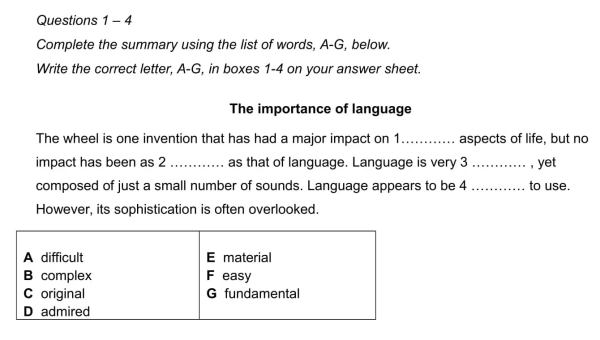
در تصویر دیگری مشاهده میکنید که فقط خلاصه متن به عنوان صورت سوال قرار داده شده و گزینهها داخل باکس قرار ندارند.
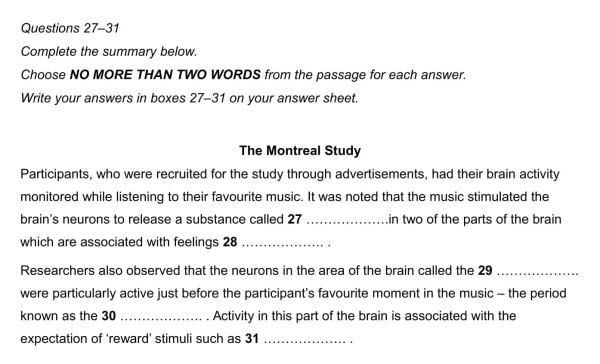
سوالات Matching Sentence Endings
پاسخ سوالات «Matching Sentence Endings» اغلب به ترتیب در متن پیدا میشوند. هدف از این نوع سوالها، وصل کردن جملهها به هم با توجه به اطلاعات موجود در متن است. به عبارت دیگر، جملههایی به صورت ناقص در صورت سوال قرار داده شدهاند و باید آنها را به بخش دوم جمله وصل کنید تا کامل شوند. برای پاسخ دادن به این نوع سوالها، لازم است نکات مهمی را مدنظر داشته باشید که در ادامه شرح داده شده است.
- پاسخ سوالها به ترتیب جملههای ناتمام در صورت سوال، در متن پیدا میشود.
- از روش حذف کردن گزینههای نادرست برای انتخاب پاسخهای درست استفاده کنید.
- تا وقتی جملههای ناقص را نخواندهاید، متن را نخوانید.
- نیازی به خواندن کل متن نیست، فقط جملههای مرتبط را بخوانید.
- بخش دوم جملهها در متن وجود دارد، اما همه آنها پاسخ درست نیستند. معمولاً تعداد آنها بیشتر از گزینههای درست است.
- مترادفها و پارافریزها در متن ظاهر میشوند، بنابراین، باید به دنبال معنی باشید نه خود کلمههای جملههای ناقص.
- ساختار گرامری دو جمله ناقص باید با هم مطابقت داشته باشد. در غیر این صورت، آنها را نباید به هم وصل کنید.
در تصویر زیر میتوانید نمونه سوالات ریدینگ آیلتس را برای «Matching Sentence Endings» مشاهده کنید.
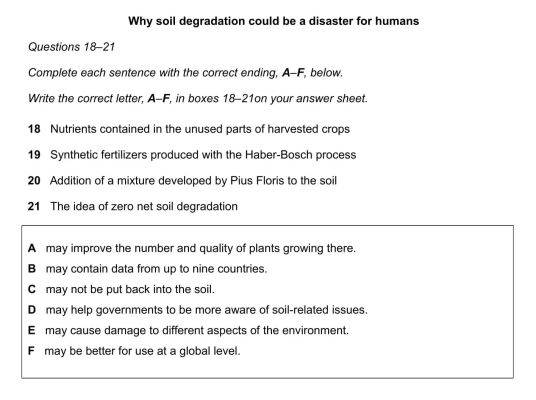
سوالات Sentence Completion
در این نوع سوالها چهار یا پنج جمله در کنار هم قرار داده میشود که برخی از آنها جاهای خالی دارد. داوطلب موظف است جاهای خالی را کامل کند تا معنی جمله درک شود. برای پاسخ دادن به این نوع سوالها، لازم است قبل از هر چیز دستورالعمل را بخوانید تا بدانید حداکثر چند کلمه میتوانید در جاهای خالی بنویسید. همچنین، میتوانید هنگام پاسخ دادن به سوالات «Sentence Completion» نکات زیر را رعایت کنید تا کمتر دچار اشتباه شوید و سرعت تست زدن افزایش یابد.
- دستورالعمل را با دقت بخوانید و تعداد کلمههای مجاز برای نوشتن در جاهای خالی را در نظر بگیرید.
- قبل از خواندن کل متن، ابتدا جملهها را بخوانید. خواندن کل متن فقط وقت تلف کردن است و توصیه نمیشود. زیرا وقتی هنوز نمیدانید به دنبال چه اطلاعاتی هستید، لزومی ندارد که کل متن را بخوانید.
- سوالها به همان ترتیبی در متن ظاهر میشوند که در جملههای ناقص در صورت سوال قرار گرفتهاند.
- جملههای کامل باید از نظر گرامری درست باشند. اگر اینطور نباشد، بدون شک جای خالی را با کلمه نادرستی پر کردهاید.
- وقتی جملهها را اول از همه میخوانید، سعی کنید حدس بزنید که قرار است چه کلمهای را در جای خالی قرار دهید. برای مثال، حدس بزنید که در جای خالی باید اسم، فعل، صفت، قید یا سار اجزای کلام قرار بگیرد.
- از تکنیک «scanning» استفاده کنید تا به بخشی از متن برسید که ممکن است پاسخ سوال خود را در آن قسمت بیابید.
- همیشه به مترادفها یا پارافریزها پیدا کنید و به دنبال خود کلمههای کلیدی در متن نباشید.
در تصویر زیر میتوانید نمونه سوالات ریدینگ آیلتس را برای «Sentence Completion» مشاهده کنید.
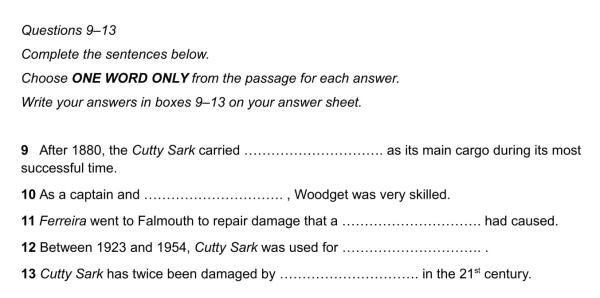
سوالات Matching Paragraph Information
در این نوع سوالها، سه تا شش جمله مطرح میشود و داوطلب موظف است اطلاعات هر جمله را به اطلاعات پاراگرافهای متن وصل کند. برای پاسخ دادن به سوالهای این بخش، باید به مهارت «skimming» و «scanning» تسلط کافی داشته باشید و بتوانید مترادف یا پارافریز کلمههای کلیدی را در متن پیدا کنید. برای اینکه بتوانید به خوبی از عهده این بخش بربیایید، لازم است به نکات زیر توجه داشته باشید.
- پاسخها به ترتیب در متن ظاهر نمیشوند.
- در برخی از پاراگرافها ممکن است اصلاً پاسخی نباشد.
- در یک پاراگراف ممکن است بیش از یک پاسخ وجود داشته باشد.
- پاسخ سوال ضرورتاً در «ایده محوری» (Topic Sentence) وجود ندارد. در صورتی که در رابطه با سوالات «Matching headings» چنین حالتی وجود دارد، زیرا به دنبال اطلاعات خاصی هستیم. برخی از داوطلبان، این دو نوع سوال را با هم اشتباه میگیرند. بنابراین، مطمئن شوید که میدانید به کدام سوال پاسخ میدهید.
- سعی کنید اول به سوالهای دیگر پاسخ دهید. هر متن از چند نوع سوال مختلف تشکیل شده است. اگر با متنی مواجه شدید که سوالات «Matching Paragraph Information» را داشت، سعی کنید ابتدا به سراغ سوالهای دیگر بروید و در انتها برای این سوالها وقت بگذارید.
- علاوه بر مترادفها، مراقب اطلاعاتی در متن باشید که به صورت عدد و حروف وجود دارد. برای مثال «½» که «a half» نوشته میشود یا « 69%» که «sixty-nine percent» نوشته میشود.
- اغلب اطلاعات را به صورت عبارت یا جمله در متن پیدا میکنید نه در یک کلمه.
- به دنبال پیدا کردن پاسخهای سادهتر باشید تا بتوانید آنها را سریعتر پاسخ دهید و در نهایت برای پاسخ دادن به سوالهای سختتر، گزینههای بیشتری حذف شده باشد. گزینههای سادهتر شامل مواردی میشود که اسمهای خاص، اعداد، نام مکانها و تاریخها را در جمله میبینیم. چون این کلمههای کلیدی را میتوان عیناً در متن پیدا کرد.
- میتوانید با روش حذف گزینهها به پاسخ سریعتر دست پیدا کنید. برای هر جملهای، پاراگرافهایی وجود دارد که به طور کامل با اطلاعات موجود در متن مطابقت ندارد. به راحتی میتوانید این موارد را مشخص و حذف کنید.
در تصویر زیر میتوانید نمونه سوالات ریدینگ آیلتس را برای «Matching Paragraph Information» مشاهده کنید.
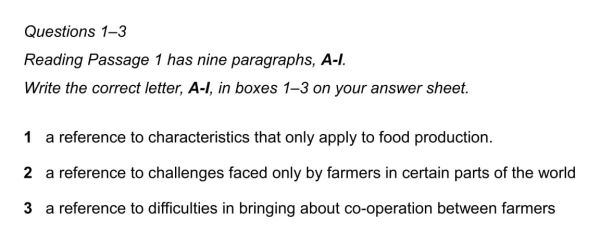
سوالات Table Completion
نمونه سوالهای «Table Completion» را نیز ممکن در آزمونهای سالهای قبل آیلتس زیاد ببینید. این نوع سوالها معمولاً در مقایسه با سوالهای دیگر کمی سختتر است، اما اگر تکنیکهای پاسخگویی به آنها را یاد بگیرید، میتوانید تعداد زیادی از پاسخها را درست جواب دهید.
در این نوع سوالها، جدولی به عنوان سوال مطرح شده است که داوطلب باید جاهای خالی آن را پر کند. کلمهها باید از خود متن پیدا شود و طبق دستورالعمل، از تعداد کلمههای تعیین شده بیشتر نباشد.
علاوه بر جدول، ممکن است «Flowchart» نیز به عنوان سوال مطرح شود. تنها تفاوت میان آنها به نحوه اطلاعاتی مربوط میشود که در صورت سوال چیده شده است. اما در کل شیوه پاسخگویی یکسان است. مهارتهای «skimming» و «scanning» برای این نوع سوالها بسیار مهم است و تشخیص مترادفها و پارافریزها نیز میتواند کمک زیادی به پیدا کردن جواب بکند. در ادامه، سعی کردهایم به نکات مهمی در خصوص پاسخ به سوالات «Table Completion» اشاره کنیم.
- سوالات «Table Completion» و «Flowchart» به آن اندازهای که به نظر میرسند سخت نیستند. اگر راهکارها را به صورت مرحله به مرحله رعایت کنید، با مشکل خاصی مواجه نخواهید شد.
- این نوع سوالها میتوانند به شکلهای مختلفی، مانند «Flowchart» ارائه شوند. شکل ظاهری آنها شاید متفاوت باشد، اما همه از یک استراتژی برای پاسخگویی پیروی میکنند.
- اطلاعاتی که در جدول قرار داده شده، ممکن است به ترتیب در متن پیدا نشود.
- جاهای خالی را باید دقیقاً با کلمههای داخل متن پر کنید، یعنی نباید تغییری در کلمه ایجاد کنید. برای مثال نمیتوانید آن را از اسم به فعل تبدیل کنید با برعکس.
- وقتی مشغول خواندن جدول هستید، سعی کنید حدس بزنید که در جای خالی باید چه نوع کلمهای قرار داده شود، مانند اسم، فعل یا صفت. این کار به شما کمک میکند تا پاسخ سوال را سریعتر پیدا کنید.
- همیشه به مترادفها و پارافریزها فکر کنید. بهجای پیدا کردن کلمه، به دنبال پیدا کردن مترادف یا کلمه هممعنی آن در متن باشید.
- متن را «scan» کنید تا بتوانید به پاسخ درست برسید. سپس آن قسمت را دقیق و با تمام جزئیات بخوانید.
- جملههای کامل باید از نظر گرامری درست باشند. یعنی وقتی جای خالی را پر میکنید، مطمئن شوید که ساختار گرامری جمله درست است.
- از هر سرنخی در جدول برای کمک به درک نوع اطلاعات مورد نیاز خود استفاده کنید.
در تصویر زیر میتوانید نمونه سوالات ریدینگ آیلتس «Table Completion» مشاهده کنید.
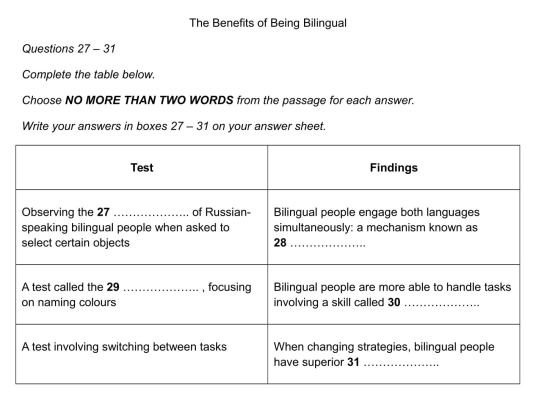
در تصویر زیر میتوانید نمونه سوالات ریدینگ آیلتس «Flowchart» مشاهده کنید.
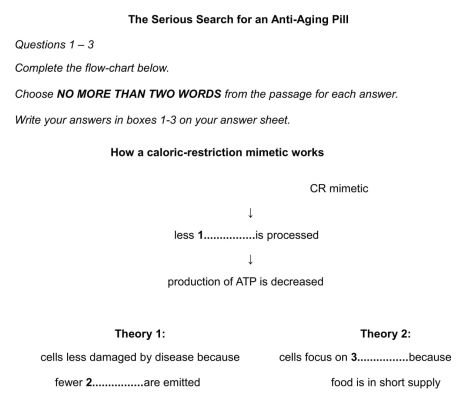
سوالات Diagram Labelling
این نوع سوالها معمولاً برای داوطلبان آزمون آیلتس بسیار چالشبرانگیز است، زیرا با دیدن آن ممکن است از اینکه شاید نتوانند آن را درک کنند، نگران شوند. نیازی به فهمیدن کامل مطلب نیست. فقط لازم است مانند سایر نمونه سوالات ریدینگ آیلتس اطلاعات لازم را درک کنید و در متن به دنبال آنها بگردید.
- در سوالات «Diagram Labelling» به شما دیاگرام یا طرحی به عنوان سوال داده میشود که باید بخشهای خاصی از آن را با کلمههای موجود در متن یا فهرست داده شده، پر کنید. در ادامه به راهکارهایی برای پاسخ دادن به این نوع سوالهای اشاره میکنیم.
- دستورالعملها را با دقت بخوانید. ابتدا دریابید که باید با کلمههای موجود در متن جاهای خالی دیاگرام را پر کنید یا با کلمههایی که در باکس سوال قرار دارد باید این کار را انجام دهید. اگر قرار است حداکثر دو کلمه بنویسید، مراقب باشید که بیشتر از آن نشود، زیر نمره خود را حتی در صورت درست جواب دادن از دست خواهید داد.
- به طور خلاصه به دیاگرام نگاهی ییندازید و درک کلی از مفهوم آن به دست آورید. سرنخهایی در عنوانها، اعداد، و هر موردی مانند اینها میتوانید پیدا کنید.
- متن را برای پیدا کردن کلمههای کلیدی «scan» کنید. تشخیص دهید که پاسخها دقیقاً کجای متن قرار دارند.
- بخشهای مرتبط با متن را با دقت بخوانید تا بتوانید به هر یک از سوالها به درستی پاسخ دهید.
در تصویر زیر نمونهای از سوالات «Diagram Labelling» را مشاهده میکنید که مربوط به یکی از آزمونهای آیلتس سالهای قبل است.

نمونه سوالات ریدینگ آیلتس با جواب
پس از آنکه با انواع سوالات ریدینگ آیلتس آشنا شدیم و تکنیکهای پاسخ دادن به آنها را یاد گرفتیم، نوبت به تمرین کردن و تست زدن میرسد. برای این کار میتوانید از نمونه آزمونهای سالهای قبل کمک بگیرید که به آن «آزمون ماک آیلتس» (IELTS Mock Test) گفته میشود. این آزمونها هم در محل برگزاری آزمون و در شرایطی مشابه با آزمون اصلی برگزار میشود و هم به صورت آنلاین در دسترس است.
علاوه بر آزمون ماک، برای داشتن نمونه سوالات ریدینگ آیلتس میتوانید از تستهای کمبریج استفاده کنید. هر یک از این کتابها شامل چهار آزمون است که هم برای آکادمیک و هم جنرال به طور مجزا در نظر گرفته شده است. به منظور آمادگی برای بخش ریدینگ میتوانیم از بخش ریدینگ آن استفاده کنیم.
تا به اینجای مطلب، شما را با ساختار ریدینگ آزمون آیلتس آشنا کردیم و انواع سوالات آن را به کمک نمونه شرح دادیم. همچنین به راهکارهای پاسخگویی به سوالها اشاره کردیم. در ادامه قصد داریم به نمونه سوالات ریدینگ آیلتس با جواب اشاره کنیم. که برای هر یک از سوالات ریدینگ به طور مجزا بررسی خواهد شد.
نمونه سوالات Matching Headings با جواب
به نمونه سوال «Matching Headings» توجه کنید که از یکی از آزمونهای آیلتس سالهای قبل انتخاب شده است. پاسخ آن نیز در انتهای سوال آمده است.
Questions 1 – 4
Reading Passage 1 has five sections, A-E.
Choose the correct heading for each section from the list of headings below.
Write the correct number, i-viii, in boxes 1-4 on your answer sheet.
|
List of Headings i Dramatic effects can result from small changes in traffic just as in nature viii A proposal to take control away from the driver |
1. Section A
| Example
Section B i |
2. Section C
3. Section D
4. Section E
The Physics of Traffic Behavior
A Some years ago, when several theoretical physicists, principally Dirk Helbing and Boris Kerner of Stuttgart, Germany, began publishing papers on traffic flow in publications normally read by traffic engineers, they were clearly working outside their usual sphere of investigation. They had noticed that if they simulated the movement of vehicles on a highway, using the equations that describe how the molecules of a gas move, some very strange results emerged. Of course, vehicles do not behave exactly like gas molecules: for example, drivers try to avoid collisions by slowing down when they get too near another vehicle, whereas gas molecules have no such concern. However, the physicists modified the equations to take the differences into account and the overall description of traffic as a flowing gas has proved to be a very good one; the moving-gas model of traffic reproduces many phenomena seen in real-world traffic.
The strangest thing that came out of these equations, however, was the implication that congestion can arise completely spontaneously; no external causes are necessary. Vehicles can be flowing freely along, at a density still well below what the road can handle, and then suddenly gel into a slow-moving ooze. Under the right conditions a brief and local fluctuation in the speed or the distance between vehicles is all it takes to trigger a system-wide breakdown that persists for hours. In fact, the physicists’ analysis suggested
such spontaneous breakdowns in traffic flow probably occur quite frequently on highways.
B Though a decidedly unsettling discovery, this showed striking similarities to the
phenomena popularized as ‘chaos theory’. This theory has arisen from the understanding that in any complex interacting system which is made of many parts, each part affects the others. Consequently, tiny variations in one part of a complex system can grow in huge but unpredictable ways. This type of dramatic change from one state to another is similar to what happens when a chemical substance changes from a vapor to a liquid. It often happens that water in a cloud remains as a gas even after its temperature and density have
reached the point where it could condense into water droplets. However, if the vapor encounters a solid surface, even something as small as a speck of dust, condensation can take place and the transition from vapor to liquid finally occurs. Helbing and Kerner see traffic as a complex interacting system. They found that a small fluctuation in traffic density can act as the ‘speck of dust’ causing a sudden change from freely moving traffic to synchronized traffic, when vehicles in all lanes abruptly slow down and start moving at the same speed, making passing impossible.
C The physicists have challenged proposals to set a maximum capacity for vehicles on highways. They argue that it may not be enough simply to limit the rate at which vehicles are allowed to enter a highway, rather, it may be necessary to time each vehicle’s entry onto a highway precisely to coincide with a temporary drop in the density of vehicles along the road. The aim of doing this would be to smooth out any possible fluctuations in the road conditions that can trigger a change in traffic behavior and result in congestion. They further suggest that preventing breakdowns in the flow of traffic could ultimately require implementing the radical idea that has been suggested from time to time: directly regulating the speed and spacing of individual cars along a highway with central computers and sensors that communicate with each car’s engine and brake controls.
D However, research into traffic control is generally centered in civil engineering departments and here the theories of the physicists have been greeted with some skepticism. Civil engineers favor a practical approach to problems and believe traffic congestion is the result of poor road construction (two lanes becoming one lane or dangerous curves), which constricts the flow of traffic. Engineers questioned how well the physicists’ theoretical results relate to traffic in the real world. Indeed, some engineering researchers questioned whether elaborate chaos-theory interpretations are needed at all, since at least some of the traffic phenomena the physicists’ theories predicted seemed to be similar to observations that had been appearing in traffic engineering literature under other names for years; observations which had straightforward cause-and-effect explanations.
E James Banks, a professor of civil and environmental engineering at San Diego State University in the US, suggested that a sudden slowdown in traffic may have less to do with chaos theory than with driver psychology. As traffic gets heavier and the passing lane gets more crowded, aggressive drivers move to other lanes to try to pass, which also tends to even out the speed between lanes. He also felt that another leveling force is that when a driver in a fast lane brakes a little to maintain a safe distance between vehicles, the shock wave travels back much more rapidly than it would in the other slower lanes, because each following driver has to react more quickly. Consequently, as a road becomes congested, the faster-moving traffic is the first to slow down.
Answers
1. How a concept from one field of study was applied in another
2. A proposal to take control away from the driver
3. Areas of doubt and disagreement between experts
4. The impact of driver behavior on traffic spee
نمونه سوالات Multiple Choice با جواب
به نمونه سوال «Matching Headings» توجه کنید که از یکی از آزمونهای آیلتس سالهای قبل انتخاب شده است. پاسخ آن نیز در انتهای سوال آمده است.
The general assumption is that older workers are paid more in spite of, rather than because of, their productivity. That might partly explain why, when employers are under pressure tocut costs, they persuade a 55-year old to take early retirement. Take away seniority-based pay scales and older workers may become a much more attractive employment proposition. But most employers and many workers are uncomfortable with the idea of reducing someone’s pay in later life – although manual workers on piece rates often earn less as they
get older. So retaining the services of older workers may mean employing them in different ways.
One innovation was devised by IBM Belgium. Faced with the need to cut staff costs, and having decided to concentrate cuts on 55 to 60-year olds, IBM set up a separate company called Skill Team, which re-employed any of the early retired who wanted to go on working up to the age of 60. An employee who joined Skill Team at the age of 55 on a five-year contract would work for 58% of his time, over the full period, for 88% of his last IBM salary. The company offered services to IBM, thus allowing it to retain access to some of the
intellectual capital it would otherwise have lost.
The best way to tempt the old to go on working may be to build on such ‘bridge’ jobs: part-time or temporary employment that creates a more gradual transition from full-time work to retirement. Studies have found that, in the United States, nearly half of all men and women who had been in full-time jobs in middle age moved into such ‘bridge’ jobs at the end of their working lives. In general, it is the best-paid and worst-paid who carry on working. There seem to be two very different types of bridge job-holder – those who continue working
because they have to and those who continue working because they want to, even though they could afford to retire.
If the job market grows more flexible, the old may find more jobs that suit them. Often, they will be self-employed. Sometimes, they may start their own businesses: a study by David Storey of Warwick University found that in Britain 70% of businesses started by people over 55 survived, compared with an overall national average of only 19%. But whatever pattern of employment they choose, in the coming years the skills of these 'grey workers' will have to be increasingly acknowledged and rewarded.
Questions 1 – 4
Choose the correct letter, A, B, C or D.
Write the correct letter in boxes 1-4 on your answer sheet.
1. In paragraph one, the writer suggests that companies could consider
A abolishing pay schemes that are based on age.
B avoiding pay that is based on piece-rates.
C increasing pay for older workers.
D equipping older workers with new skills.
2. Skill Team is an example of a company which
A offers older workers increases in salary.
B allows people to continue working for as long as they want.
C allows the expertise of older workers to be put to use.
D treats older and younger workers equally.
3. According to the writer, ‘bridge’ jobs
A tend to attract people in middle-salary ranges.
B are better paid than some full-time jobs.
C originated in the United States.
D appeal to distinct groups of older workers.
4. David Storey’s study found that
A people demand more from their work as they get older.
B older people are good at running their own businesses.
C an increasing number of old people are self-employed.
D few young people have their own businesses.
Answers
1. A abolishing pay schemes that are based on age
2. C allows the expertise of older workers to be put to use
3. D appeal to distinct groups of older workers
4. B older people are good at running their own business
نمونه سوالات Short Answer با جواب
به نمونه سوال «Matching Headings» توجه کنید که از یکی از آزمونهای آیلتس سالهای قبل انتخاب شده است. پاسخ آن نیز در انتهای سوال آمده است.
Questions 4 – 8
Answer the questions below.
Choose NO MORE THAN THREE WORDS AND/OR A NUMBER from the text for each answer.
Write your answers in boxes 4-8 on your answer sheet.
4. What has been found in some Fancy Foods products?
5. Where can you find the batch number on the jars?
6. How much will you receive for an opened jar of contaminated Chicken Curry?
7. If you have eaten Chicken Curry from a jar with one of the batch numbers listed, whom
should you contact?
8. What is the maximum reward Fancy Foods is offering for information about who
contaminated their product?
IMPORTANT NOTICE: PRODUCT RETURN
Fancy Foods wishes to inform the public that pieces of metal have been found in some jars of Fancy Foods Chicken Curry (Spicy). The batches of the jars involved have numbers from J6617 to J6624. The batch number is printed on the bottom of each jar. If you have any jars with these batch numbers, please return them (preferably unopened) to the supermarket where you purchased them. You can also return them to the factory (Fancy Foods Retailers,
Blacktown). Fancy Foods will pay $10 for each jar returned unopened and $5 for each jar already opened.
No payment will be made for empty jars, which do not need to be returned. However, the Retailing Manager will be interested to hear from people who have consumed chicken curry from any of the above batch numbers. In particular, it will be helpful if they can give information about the place of purchase of the product.
Jars of Fancy Foods Chicken Curry (Coconut) and Fancy Foods Chicken Curry (Mango) have not been affected and do not need to be returned.
REWARD
Fancy Foods will pay a reward of $10,000 to $50,000 for information which leads to the conviction of any person found guilty of placing metal pieces in its products. If you have such information, please contact the Customer Relations Manager, Fancy Foods Retailers, Blacktown.
Answers
4. pieces of metal
5. (on) the bottom
6. $5
7. (the) Retailing Manager
8. $50,000
نمونه سوالات Name Matching با جواب
به نمونه سوال «Matching Headings» توجه کنید که از یکی از آزمونهای آیلتس سالهای قبل انتخاب شده است. پاسخ آن نیز در انتهای سوال آمده است.
Questions 1–4
Look at the following ideas (Questions 1–4) and the list of researchers below.
Match each idea with the correct researcher, A, B, C or D.
Write the correct letter, A, B, C or D, in the boxes 1–4 on your answer sheet.
1. the importance of yoga in decreasing the main hormone linked to stress
2. the advantage of yoga compared to relaxation in decreasing stress and anxiety
3. the significance of yoga in relation to existing cases of heart disease
4. the connection between practicing yoga and improvements in the circulatory system
|
List of Researchers A. Caroline Smith B. Jayadeva Yogendra C. Andreas Michalsen D. Vijay Bharshankar |
Answers
1. C
2. A
3. B
4. D
نمونه سوالات True/False/Not Given با جواب
به نمونه سوال «Matching Headings» توجه کنید که از یکی از آزمونهای آیلتس سالهای قبل انتخاب شده است. پاسخ آن نیز در انتهای سوال آمده است.
London to Brighton Bike Ride
The start
- The bike ride starts at Clapham Common tube station.
Your Start Time is indicated by the colour of your body number in this pack. It is also printed on the address label of the envelope. Please arrive no earlier than 30 minutes before that time. - We allocate an equal number of cyclists for each Start Time to ensure a steady flow. Please keep to the time you've been given so we can keep to our schedule and avoid delaying other riders and prevent 'bunching' further down the route.
- An Information Point, toilets and refreshment stands will be open from very early in the day.
Ride carefully
We put together as many facilities as possible to help ensure you have a trouble free day. But
we also rely on you to ride safely and with due consideration for other cyclists and road users.
Although many roads are closed to oncoming traffic, this is not always the case and you should
be aware of the possibility that there could be vehicles coming in the opposite direction. Please
do not attempt reckless overtaking whilst riding – remember it is NOT a race.
Follow all instructions
Every effort is made to ensure that the route is well signed and marshalled. Please obey all directions from police and marshals on the route. If you hear a motorcycle marshal blow his/her whistle three times, move left.
Wear a helmet
Every year we are delighted to see more riders wearing protective helmets, but we would like to see every cyclist on the ride wearing one. More than half of reported injuries in cycling accidents are to the head, and a helmet gives the best protection when the head hits the ground.
Attracting assistance
If you have an accident, ask a marshal for help; they are in contact with the support/emergency services. To call for help from our motorcycle marshals, give a 'thumbs down' signal. The marshal will do all he/she can to help, providing he/she is not already going to a more serious accident. If a motorcycle marshal slows down to help you, but you have just stopped for a rest and don't need help, please give a 'thumbs up' signal and he/she will carry on. Remember – thumbs down means 'I need help'.
In case of breakdown
Refer to your route map and make your way to a Mechanics Point. Mechanical assistance is free when you show your Rider Identity Card; you just pay for the parts.
Refreshment stops
Look out for these along the route. Most are organised by voluntary clubs and their prices give you real value for money. They are also raising money for their local communities and the British Heart Foundation, so please give them your support.
Rain or shine – be prepared
In the event of very bad weather, watch out for signs to wet weather stations en route. Good waterproofs, like a cycle cape, are essential. Our first aid staff can only supply bin liners and by the time you get one you may be very wet. However, the English summer is unpredictable – it may also be hot, so don't forget the sun protection cream as well!
If you have to drop out
We will try to pick up your bike for you on the day. Call Bike Events (01225310859) no more than two weeks after the ride to arrange collection. Sorry, we cannot guarantee this service nor can we accept liability for any loss or damage to your bike. Bike Events will hold your bike for three months, after which it may be disposed of. You will be damaged for all costs incurred in returning your cycle.
|
Questions 1 – 8 Do the following statements agree with the information given in the text? TRUE if the statement agrees with the information 1. You should not arrive more than half an hour before your allocated starting time. 2. Your Rider Identity Card will be sent to you before the event. 3. Some roads may have normal traffic flow on them. 4. Helmets are compulsory for all participants. 5. Refreshments are free to all participants during the ride. 6. If you need a rest you must get off the road. 7. First aid staff can provide cycle capes. 8. Bike Events will charge you for the return of your bike. |
Answers
1. TRUE
2. NOT GIVEN
3. TRUE
4. FALSE
5. FALSE
6. NOT GIVEN
7. FALSE
8. TRUE
نمونه سوالات Yes/No/Not Given با جواب
به نمونه سوال «Matching Headings» توجه کنید که از یکی از آزمونهای آیلتس سالهای قبل انتخاب شده است. پاسخ آن نیز در انتهای سوال آمده است.
Teens 'not damaged by screen time', study finds
There is little evidence of a link between the amount of time teenagers spend on devices and their general wellbeing, a study has suggested. It counters claims that teenagers' mental and physical health could be damaged by excessive screen time. Even just before bedtime, being online, gaming or watching TV is not damaging to young people's mental health, study authors
said. They questioned the methodology of previous studies.
"While psychological science can be a powerful tool for understanding the link between screen use and adolescent wellbeing, it still routinely fails to supply stakeholders and the public with high-quality, transparent and objective investigations into growing concerns about digital technologies," said Professor Andrew Przybylski, Director of Research at the Oxford Internet Institute (OII) and co-author of the study.
Earlier this year, the Royal College of Paediatrics and Child Health (RCPCH) reached a similar conclusion to the Oxford University study, but did suggest parents tell their children to put down their devices in the hour before they go to bed. Dr Max Davie, from RCPCH, said of the new study: "The controversy around screen use and adolescent wellbeing has always suffered from an excess of opinion relative to data, and this paper helps to correct this, "The analysis is robust and suggests an overall population effect too small to warrant consideration as a public health problem. They also question the widely held belief that screens before bedtime are especially bad for mental health. "However, none of this is intended to suggest that screen time cannot become excessive in individual cases, and we would still suggest that families follow our guidance published earlier this year. We continue, for now, to recommend that screens be avoided for one hour before bed since there are other reasons besides mental health for children to need a good night's sleep."
But others felt the study did not go far enough. Dr Bernadka Dubicka, chair of the child and adolescent faculty at the Royal College of Psychiatrists, said: "Although this is a well-conducted study involving a large data set, the conclusions can only be limited. "The study looks at how long children spend looking at screens but not at what harmful content they might see. We know that screen time is not the main driver of mental illness, but dangerous online content can have an enormous impact on young people and their mental health.
"As a frontline clinician, I regularly see young people who have deliberately hurt themselves after discussing self-harm techniques on social media. Urgent research is needed to explore the complex relationship between online content and young people, with particular attention given to the most vulnerable."
Source: BBC News website (Text edited for this practice exercise.)
Answers
1. NO
2. NO
3. YES
4. NOT GIVEN
نمونه سوالات Summary Completion با جواب
به نمونه سوال «Matching Headings» توجه کنید که از یکی از آزمونهای آیلتس سالهای قبل انتخاب شده است. پاسخ آن نیز در انتهای سوال آمده است.
'This Marvellous Invention'
Of all mankind’s manifold creations, language must take pride of place. Other inventions – the wheel, agriculture, sliced bread – may have transformed our material existence, but the advent of language is what made us human. Compared to language, all other inventions pale in significance, since everything we have ever achieved depends on language and originates from it. Without language, we could never have embarked on our ascent to unparalleled power over all other animals, and even over nature itself.
But language is foremost not just because it came first. In its own right it is a tool of extraordinary sophistication, yet based on an idea of ingenious simplicity: ‘this marvellous invention of composing out of twenty-five or thirty sounds that infinite variety of expressions which, whilst having in themselves no likeness to what is in our mind, allow us to disclose to others its whole secret, and to make known to those who cannot penetrate it all that we imagine, and all the various stirrings of our soul’. This was how, in 1660, the renowned French grammarians of the Port-Royal abbey near Versailles distilled
the essence of language, and no one since has celebrated more eloquently the magnitude of its achievement. Even so, there is just one flaw in all these hymns of praise, for the homage to language’s unique accomplishment conceals a simple yet critical incongruity. Language is mankind’s greatest invention – except, of course, that it was never invented. This apparent paradox is at the core of our fascination with language, and it holds many of its secrets.
Answers
1. E material
2. G fundamental
3. B complex
4. F easy
نمونه سوالات Matching Sentence Endings با جواب
به نمونه سوال «Matching Headings» توجه کنید که از یکی از آزمونهای آیلتس سالهای قبل انتخاب شده است. پاسخ آن نیز در انتهای سوال آمده است.
Jurassic crocodile discovery sheds light on reptiles' family tree
A A newly identified species of 150 million-year-old marine crocodile has given insights into how a group of ancient animals evolved. The ancestor of today's crocodiles belonged to a group of animals that developed a tail fin and paddle-like limbs for life in the sea, resembling dolphins more than crocodiles. These slender animals, which fed on fast-moving prey such as squid and small fish, lived during the Jurassic era in shallow seas and lagoons in what is now Germany. Related species have previously been found in Mexico and Argentina.
B An international team of scientists, including researchers from Germany and the University of Edinburgh, identified the new species from a remarkably well-preserved skeleton. The fossil was discovered in 2014 in a quarry near the town of Bamberg in Bavaria, Germany by a team from the Naturkunde-Museum Bamberg, where it is now housed. The species, Cricosaurus bambergensis, takes its name from the town.
C Researchers compared the fossil with those from other museum collections, and confirmed that it was a previously unseen species. The skeleton has several distinguishing features in its jaws, the roof of its mouth and tail, some of which have not been seen in any other species. Experts created digital images of the fossil in high resolution, to enable further research. They expect the fossil will aid greater understanding of a wider family of ancient animals, known as metriorhynchid, to which this species belonged.
D Dr Mark Young, of the University of Edinburgh's School of GeoSciences, who took part in the study, said: "The rock formations of southern Germany continue to give us fresh insights into the age of dinosaurs. These rock layers were deposited at a time when Europe was covered by a shallow sea, with countries such as Germany and the UK being a collection of islands."
E Sven Sachs, from the Naturkunde-Museum Bielefeld, who led the project, said: "The study reveals peculiar features at the palate that have not been described in any fossil crocodile so far. There are two depressions which are separated by a pronounced bar. It is not clear what these depressions were good for.
Questions 1–4
Complete each sentence with the correct ending, A–G, below.
Write the correct letter, A–G, in boxes 1–4 on your answer sheet.
1. The ancient species of crocodile ate marine creatures that
2. The skeleton is kept in
3. Bones of the early type of crocodile
4. The geology of southern Germany
| A is believed to have lived 150 million years ago. B show some unique features. C resembled dolphins. D was laid down when the area was under water. E a museum in the town near where it was found. F swam fast through the water. G the University of Edinburgh's School of GeoSciences |
Answers
1. F
2. E
3. B
4. D
نمونه سوالات Sentence Completion با جواب
به نمونه سوال «Matching Headings» توجه کنید که از یکی از آزمونهای آیلتس سالهای قبل انتخاب شده است. پاسخ آن نیز در انتهای سوال آمده است.
European Settlement of Australia
European settlement of Australia began in 1788 when a British penal colony was established on the east coast. From this starting point Australia grew rapidly and continually, expanding across the entire continent.
A number of reasons contributed to Britain's decision to colonise Australia. The most important factor was Britain's need to relieve its overcrowded prisons. Several violent incidents at overcrowded prisons convinced the British government of the need to separate unruly elements from the rest of the prison populace.
Additionally, Australia was of strategic importance to Britain, and it provided a base for the Royal Navy in the eastern sea. Also, Australia could be used as an entry point to the economic opportunities of the surrounding region. All these points figured in the decision by Lord Sydney, secretary of state of home affairs, to authorise the colonisation.
To this affect, on May 13, 1787, Captain Arthur Phillip, commanding eleven ships full of convicts, left Britain for Australia. He successfully landed a full fleet at Botany Bay on January 18, 1788. However, they left the bay eight days later because of its openness and poor soil, and settled instead at Port Jackson, a few kilometres north. The ships landed 1,373 people, including 732 convicts, and the settlement became Sydney. Australia Day is now celebrated on 26 January each year, to commemorate this first fleet landing.
Questions 1-5
Complete the following statements using NO MORE THAN THREE WORDS.
(put your choice into the gaps - use small letters and don't put any spaces after your last word)
1. Australia was originally founded as a ............
2. The major consideration in colonizing Australia was Britain’s ............
3. It was thought that ............ could be gained in that part of the world due to the access provided via Australia.
4. Lord Sydney took every factor into account when he gave official permission for the ............ of Australia.
5. Botany Bay was abandoned by the settlers due to the lack of cover and ............
Answers
1. british penal colony
2. overcrowded prisons
3. economic opportunities
4. colonisation
5. poor soil
نمونه سوالات Matching Paragraph Information با جواب
به نمونه سوال «Matching Headings» توجه کنید که از یکی از آزمونهای آیلتس سالهای قبل انتخاب شده است. پاسخ آن نیز در انتهای سوال آمده است.
SECTION 1
Questions 1 – 8
Look at the five advertisements, A-E.
Which advertisement mentions the following?
Write the correct letter, A-E, in boxes 1-8 on your answer sheet.
NB You may use any letter more than once.
1. up-to-date teaching systems
2. that the institution has been established for a significant time
3. examination classes
4. that arrangements can be made for activities outside class
5. the availability of courses for school students
6. language teaching for special purposes
7. a wide variety of language choices
8. evening classes
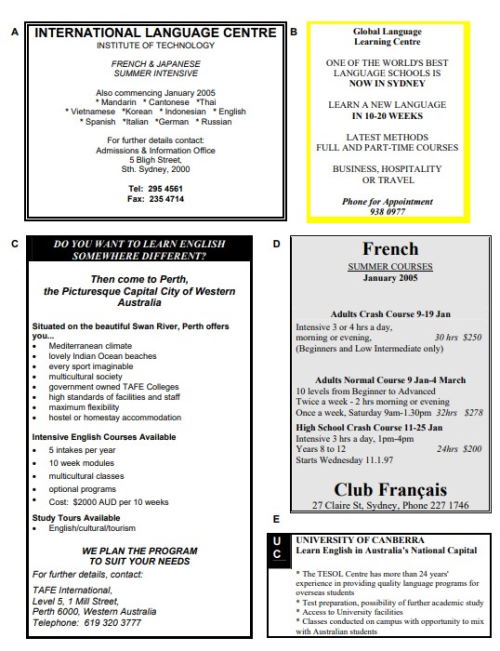
[/fdbqoute]
Answers
1. B
2. E
3. E
4. C
5. D
6. B
7. A
8. D
نمونه سوالات Table Completion با جواب
به نمونه سوال «Matching Headings» توجه کنید که از یکی از آزمونهای آیلتس سالهای قبل انتخاب شده است. پاسخ آن نیز در انتهای سوال آمده است.
Careers with Kiwi Air
Flight Attendants – Recruitment and Training Process
Recruitment
The position of Flight Attendant is one of prestige and immense responsibility. Recruitment is conducted according to operational demands and there can be periods of up to 12 months where no new intake is required. However, applications are always welcomed.
After you submit your initial application online, the Kiwi Air HR Services Team reviews the details you have provided. Candidates whose details closely match the requirements of the position are then contacted via email advising that their application has progressed to the next stage of the recruitment process. Potential candidates are then asked to attend a Walk-In Day. This could occur several weeks or months after the original application has been submitted depending on current needs.
The Walk-In Day consists of a brief presentation about the role and a short interview. Candidates who are successful on the Walk-In Day are notified within 10 days and invited to attend an Assessment Centre. Please note that candidates are required to pass a swimming test before attending the Assessment Centre. At the Assessment Centre, candidates attend an interview as well as participating in a number of assessments. Verbal references are then requested, and candidates attend a medical check.
At times, there may not be a need to recruit for Flight Attendant positions. However, the company continuously maintains a ‘recruitment pool’ of those who have completed the Assessment Centre stage. These candidates are contacted when a need for Flight Attendants is established, and attend a full interview before a decision is made on whether to extend an offer of employment.
Due to the volume of applications received, Kiwi Air is not able to offer verbal feedback to candidates at any stage of the recruitment process. Unsuccessful candidates may reapply at any time after 12 months from the date at which their applications are declined.
Training
Upon being offered a role as a trainee Flight Attendant, a 5-week training course is undertaken at our Inflight Services Training Centre in Auckland. This covers emergency procedures, customer care and service delivery, and equipment knowledge. To successfully complete the course, high standards must be attained and maintained in all subjects.
Questions 21 – 27
Complete the flowchart below.
Choose NO MORE THAN TWO WORDS from the text for each answer. Write your answers in boxes 21-27 on your answer sheet.
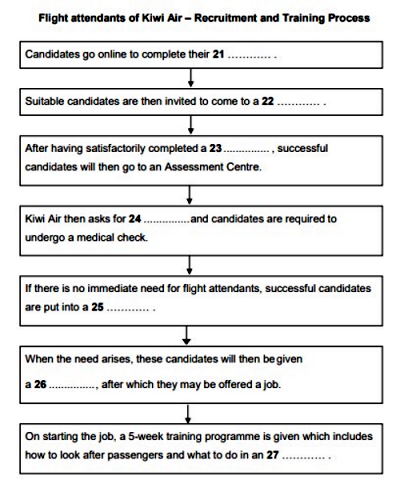
Answers
21. (initial) application
22. Walk-In Day
23. swimming test
24. verbal references
25. recruitment pool
26. full interview
27. emergency
نمونه سوالات Diagram Labelling با جواب
به نمونه سوال «Matching Headings» توجه کنید که از یکی از آزمونهای آیلتس سالهای قبل انتخاب شده است. پاسخ آن نیز در انتهای سوال آمده است.
Questions 1 – 4
Reading Passage 1 has five sections, A-E.
Choose the correct heading for each section from the list of headings below.
Write the correct number, i-viii, in boxes 1-4 on your answer sheet.
|
List of Headings i Dramatic effects can result from small changes in traffic just as in nature |
1. Section A
| Example
Section B i |
2. Section C
3. Section D
4. Section E
The Physics of Traffic Behavior
A Some years ago, when several theoretical physicists, principally Dirk Helbing and Boris Kerner of Stuttgart, Germany, began publishing papers on traffic flow in publications normally read by traffic engineers, they were clearly working outside their usual sphere of investigation. They had noticed that if they simulated the movement of vehicles on a highway, using the equations that describe how the molecules of a gas move, some very strange results emerged. Of course, vehicles do not behave exactly like gas molecules: for example, drivers try to avoid collisions by slowing down when they get too near another vehicle, whereas gas molecules have no such concern. However, the physicists modified the equations to take the differences into account and the overall description of traffic as a flowing gas has proved to be a very good
one; the moving-gas model of traffic reproduces many phenomena seen in real-world traffic.
The strangest thing that came out of these equations, however, was the implication that congestion can arise completely spontaneously; no external causes are necessary. Vehicles can be flowing freely along, at a density still well below what the road can handle, and then suddenly gel into a slow-moving ooze. Under the right conditions a brief and local fluctuation in the speed or the distance between vehicles is all it takes to trigger a system-wide breakdown
that persists for hours. In fact, the physicists’ analysis suggested such spontaneous breakdowns in traffic flow probably occur quite frequently on highways.
B Though a decidedly unsettling discovery, this showed striking similarities to the phenomena popularized as ‘chaos theory’. This theory has arisen from the understanding that in any complex interacting system which is made of many parts, each part affects the others. Consequently, tiny variations in one part of a complex system can grow in huge but unpredictable ways. This type of dramatic change from one state to another is similar to what happens when a chemical substance changes from a vapor to a liquid. It often happens that
water in a cloud remains as a gas even after its temperature and density have reached the point where it could condense into water droplets. However, if the vapor encounters a solid surface, even something as small as a speck of dust, condensation can take place and the transition from vapor to liquid finally occurs. Helbing and Kerner see traffic as a complex interacting system. They found that a small fluctuation in traffic density can act as the ‘speck of dust’
causing a sudden change from freely moving traffic to synchronized traffic, when vehicles in all lanes abruptly slow down and start moving at the same speed, making passing impossible.
C The physicists have challenged proposals to set a maximum capacity for vehicles on highways. They argue that it may not be enough simply to limit the rate at which vehicles are allowed to enter a highway; rather, it may be necessary to time each vehicle’s entry onto a highway precisely to coincide with a temporary drop in the density of vehicles along the road.
The aim of doing this would be to smooth out any possible fluctuations in the road conditions that can trigger a change in traffic behavior and result in congestion. They further suggest that preventing breakdowns in the flow of traffic could ultimately require implementing the radical idea that has been suggested from time to time: directly regulating the speed and spacing of
individual cars along a highway with central computers and sensors that communicate with each car’s engine and brake controls.
D However, research into traffic control is generally centered in civil engineering departments and here the theories of the physicists have been greeted with some skepticism. Civil engineers favor a practical approach to problems and believe traffic congestion is the result of poor road construction (two lanes becoming one lane or However, research into traffic control is generally centered in civil engineering departments and here the theories of the physicists have been greeted with some skepticism. Civil engineers favor a practical approach to problems and believe traffic congestion is the result of poor road construction (two lanes becoming one lane or dangerous curves), which constricts the flow of traffic. Engineers questioned how well the physicists’ theoretical results relate to traffic in the real world. Indeed, some engineering researchers questioned whether elaborate chaos-theory interpretations are needed at all, since at least some of the traffic phenomena the physicists’ theories predicted seemed to be similar to observations that had been appearing in traffic engineering literature under other names for years, observations which had straightforward cause-and-effect explanations.
E James Banks, a professor of civil and environmental engineering at San Diego State University in the US, suggested that a sudden slowdown in traffic may have less to do with chaos theory than with driver psychology. As traffic gets heavier and the passing lane gets more crowded, aggressive drivers move to other lanes to try to pass, which also tends to even out the speed between lanes. He also felt that another leveling force is that when a driver in a fast lane brakes a little to maintain a safe distance between vehicles, the shock wave travels back much more rapidly than it would in the other slower lanes, because each following driver has to react more quickly. Consequently, as a road becomes congested, the faster moving traffic is the first to slow down.
Answers
Diagram Labelling
1. Section A iii
2. Section C viii
3. Section D v
4. Section E vii

نمره دهی ریدینگ آیلتس
نمرهدهی ریدینگ آیلتس برای دو آزمون آکادمیک و جنرال متفاوت است. برای نمرهدهی ریدینگ، باید به جدول نمرهدهی اشاره کنیم. برای این منظور در ادامه میتوانید جدول نمرهدهی ریدینگ آیلتس آکادمیک را مشاهده کنید.
| نمره دهی ریدینگ آیلتس جنرال | |
| پاسخهای درست | نمره کل |
| 40 | 9 |
| 39 | 8.5 |
| 37-38 | 8 |
| 36 | 7.5 |
| 34-35 | 7 |
| 32-33 | 6.5 |
| 30-31 | 6 |
| 27-29 | 5.5 |
| 23-26 | 5 |
| 19-22 | 4.5 |
| 15-18 | 4 |
| 12-14 | 3.5 |
| 9-11 | 3 |
| 6-8 | 2.5 |
در جدول زیر میتوانید نمرهدهی ریدینگ آیلتس جنرال را مشاهده کنید.
| نمره دهی ریدینگ آیلتس آکادمیک | |
| پاسخهای درست | نمره کل |
| 40-39 | 9 |
| 38-37 | 8.5 |
| 36-35 | 8 |
| 34-33 | 7.5 |
| 32-30 | 7 |
| 29-27 | 6.5 |
| 26-23 | 6 |
| 22-19 | 5.5 |
| 18-15 | 5 |
| 14-13 | 4.5 |
| 12-10 | 4 |
| 9-8 | 3.5 |
| 7-6 | 3 |
| 5-4 | 2.5 |
نکات مهم درباره ریدینگ آیلتس
برای اینکه بتوانید به خوبی از عهده بخش ریدینگ آیلتس آکادمیک بربیایید، لازم است نکات مهمی را نیز رعایت کنید. در ادامه به این نکات اشاره خواهیم کرد.
- سعی کنید همه مهارتهای ریدینگ آیلتس را یاد بگیرید و تمرین کنید.
- از تکنیکهای «skimming» و «scanning» استفاده کنید تا سرعت عمل شما در پاسخگویی به سوالات بالا برود.
- مهارتهای تندخوانی را در خود تقویت کنید.
- سعی نکنید کل متن را بخوانید یا همه جزئیات آن را بفهمید.
- دامنه واژگان خود را بهبود دهید.
- کلمههای کلیدی را درست تشخیص دهید.
- گرامر خود را تقویت کنید تا هنگام پاسخ دادن به سوالها، ساختارهای گرامری درستی را به کار ببرید.
- به یاد داشته باشید که تمرینهای منظم و پیوسته میتواند در نهایت شما را به هدف خود برساند. پس زمان کافی به مطالعه و تست زدن اختصاص دهید.
- به متنهای سخت عادت کنید. هر چقدر متنهای سختتری را تمرین کنید، در روز آزمون راحتتر میتوانید از پس سوالها بربیایید.
- از آزمونهای ماک آیلتس به طور منظم استفاده کنید تا برای آزمون اصلی آمادگی کافی پیدا کنید. اگر بتوانید در همان محل برگزاری، آزمون ماک بدهید، میتوانید با محیط و شرایط آنجا آشنایی کافی پیدا کنید و روز آزمون استرس کمتری خواهید داشت.
- بعد از هر آزمون، اشتباهات خود را بررسی کنید. نقاط ضعف خود را پیدا کنید و درصدد رفع آنها بربیایید.
- واقعبین باشید. اگر فکر میکنید سطح شما در حد آزمون آیلتس نیست، ابتدا سعی کنید دورههای ترمیک را بگذرانید تا به سطح قابلقبولی برسید. سپس خود را برای آزمون محک بزنید.
- برای مطالعه خود برنامهریزی داشته باشید. اگر به طور مرتب یا روزانه زمان مشخصی را به مطالعه اختصاص دهید، نتیجه بسیار خوبی میگیرید، زیرا آمادگی برای آزمون نیازمند صرف وقت و انگیز کافی است و برای این کار باید برنامه مطالعاتی هدفمندی را در نظر بگیرید.

سوالات رایج درباره نمونه سوالات ریدینگ آیلتس
در این آموزش سعی کردهایم به تعدادی از پرسشهای رایج درباره نمونه سوالات ریدینگ آیلتس پاسخ دهیم.
آزمون آیلتس چند نوع نمونه سوالات ریدینگ دارد؟
آزمون ریدینگ آیلتس از نمونه سوالات متعددی تشکیل شده است، اما به طور کلی ۱۲ نوع مختلف را برای آن در نظر گرفتهاند که برای پاسخ دادن به آنها، باید با تکنیکهای پاسخدهی به سوالات به طور کامل آشنا شویم و نکات لازم را درمورد آنها بدانیم.
چه تکنیکهایی برای خواندن متن ریدینگ به کار میرود؟
برای صرفهجویی در وقت و افزایش سرعت خواندن متن، دو تکنیک «skimming» و «scanning» کاربرد زیادی دارد. روش اول شامل خواندن سریع متن برای درک موضوع اصلی یا همان مفهوم کلی من است و روش دوم به منظور پیدا کردن کلمههای کلیدی در متن انجام میشود که شامل مترادف و پارافریز است.
آیا برای بخش سوم سوالات ریدینگ آیلتس نمره بیشتری در نظر گرفته شده است؟
برای هر یک از نمونه سوالات ریدینگ آیلتس یک نمره در نظر گرفته شده است، اما سختی سوالها در هر بخش و با توجه به نوع سوال فرق میکند. برای مثال، در بخش سوم، معمولاً سوالات سختتری مطرح میشود. اما در مجموع، نمرهدهی سوالها فرقی با هم ندارد.
آیا سوالات ریدینگ آیلتس نمره منفی دارد؟
هیچ نمره منفی برای هیچیک از بخشهای آزمون در نظر گرفته نشده است. حتی توصیه میشود که اگر پاسخ سوالی را نمیدانید، یکی از گزینهها را به صورت اتفاقی انتخاب کنید یا جای خالی را با کلمهای از متن پر کنید. زیرا احتمال اینکه پاسخ شما درست باشد، بین ۲۵ تا ۳۰ درصد است.
برای هر بخش از سوالات ریدینگ آیلتس باید زمان یکسانی را اختصاص دهیم؟
مدت زمان پاسخدهی به سوالات ریدینگ آیلتس در مجموع ۶۰ دقیقه است. بنابراین، به طور میانگین، برای هر بخش ۲۰ دقیقه فرصت دارید. اما از آنجا که سوالات بخش سوم معمولاً سختتر است، بهتر است زمان بیشتری را برای آن در نظر بگیرید.
جمعبندی
در این آموزش، نمونه سوالات ریدینگ آیلتس را ارائه کردیم و پاسخ آنها را نیز قرار دادیم. همچنین ساختار کلی ریدینگ آیلتس آکادمیک و جنرال را به طور کامل بررسی کردیم و با تفاوتهای آنها آشنا شدیم. در ادامه، به نحوه نمرهدهی ریدینگ آیلتس پرداختیم و سپس نکات مهمی را در رابطه با نمونه سوالات ریدینگ آیلتس توضیح دادیم. در پایان نیز به تعدادی از سوالهای رایج در خصوص ریدینگ پاسخ دادیم.
در مجموع، به منظور آمادگی برای بخش ریدینگ آزمون آیلتس، قدم اول این است که هدف خود را از شرکت در آزمون مشخص کنیم. به عبارت دیگر، باید بدانیم که قصد شرکت در آزمون آکادمیک یا جنرال را داریم. پس از آن، نوبت به انتخاب منابع مناسب برای مطالعه در این زمینه میرسد. در این کتابها، انواع سوالات ریدینگ معرفی شدهاند و تکنیکهای پاسخگویی به هر یک از آنها به کمک مثالهای متعدد شرح داده شده است.
پس از اینکه با انواع سوالها آشنایی کامل پیدا کردید، میتوانید به سراغ آزمونهای ماک آیلتس بروید و میزان پیشرفت خود را ارزیابی کنید. در این مرحله، نمونه سوالات ریدینگ آیلتس میتواند کمک بسیار زیادی به شما در جهت بهبود مهارتهای خواندن و درک مطلب بکند.
هر چقدر تمرین بیشتری بکنید، موفقی بیشتری حاصل خواهد شد. این نکته را نیز فراموش نکنید که نمونه سوالات ریدینگ آیلتس روش مؤثری پی بردن به اشتباهات خود و تحلیل آنهاست. به همین دلیل میتواند به مرور در عملکرد شما تأثیر بسزایی داشته باشد. سعی کنید با زدن هر تست و یادگیری تکنیکهای پاسخ دادن به آن، نقاط ضعف خود را شناسایی کنید تا در آزمونهای بعدی آنها را تکرار نکنید.
مطلبی که در بالا مطالعه کردید بخشی از مجموعه مطالب «راهنمای آزمون های زبان انگلیسی» است. در ادامه، میتوانید فهرست این مطالب را ببینید:
- آیلتس چیست ؟ — هر آنچه باید درباره آزمون IELTS بدانید
- برای گرفتن مدرک آیلتس از کجا شروع کنیم؟ — راهنمای آمادگی آزمون IELTS
- آیلتس و تافل چیست؟ | همه آنچه باید قبل آزمون بدانید — به زبان ساده
- تفاوت تافل و آیلتس چیست | کجا کدام بهتر است؟ — مقایسه جامع
- بهترین منابع لغت آیلتس — لیست جامع منابع IELTS Vocabulary
- بهترین منابع Listening آیلتس – لیست جامع منابع لیسنینگ IELTS
- آزمون دولینگو چیست و مناسب کیست ؟ + منابع آزمون Duolingo
- آزمون MSRT چیست ؟ – هر آنچه باید درباره امتحان ام اس آر تی بدانید
- CEFR چیست ؟ — همه چیز درباره آزمون و Level ها
- آموزش رایتینگ آیلتس – از صفر تا صد
- تافل چیست ؟ – راهنمای آزمون TOEFL در سال 2021
- معرفی بهترین منابع شروع خواندن برای آیلتس – راهنمای موفقیت در آزمون
- نمونه رایتینگ آیلتس آکادمیک – سوال به همراه پاسخ
- راهنمای آمادگی برای آزمون آیلتس بدون کلاس – کاربردی ترین روش ها و منابع
- تفاوت آیلتس جنرال و آکادمیک چیست ؟ – آنچه باید بدانید
- لغات ضروری آیلتس با ترجمه فارسی – کاملترین فهرست
- کتاب های آیلتس جنرال که باید بخوانید — برای تقویت همه مهارت ها
- آزمون ماک آیلتس چیست ؟ + توضیح ویژگی های یک امتحان کاربردی
- آمادگی برای تافل از صفر – راهنمای شروع تا موفقیت در امتحان
- بهترین منابع ریدینگ آیلتس – آنچه برای نمره ریدینگ لازم دارید
- بهترین پادکست انگلیسی برای آیلتس – معرفی 12 پادکست کاربردی
- بهترین کتاب رایتینگ آیلتس چیست ؟ — معرفی 24 عنوان ضروری
- بهترین کتاب ریدینگ آیلتس چیست ؟ — فهرست ضروری که باید بخوانید
- ۱۲ تکنیک تقویت اسپیکینگ تافل — افزایش مهارت با راههای کاربردی
- 8 پادکست برای تقویت لیسنینگ آیلتس — معرفی و لینک دانلود
- معرفی کتاب لغات آیلتس – بهترین و ضروری ترین عناوین
- منابع خودآموز آیلتس — 20 منبع ضروری برای موفقیت در آزمون
- نحوه مطالعه برای آزمون آیلتس — از برنامه ریزی تا منابع مطالعه
- نمره دهی ریدینگ آیلتس چگونه است؟ – توضیح نحوه محاسبه
- نمونه ریدینگ آیلتس جنرال + سوال، تمرین و تکنیک های کاربردی
- نمونه سوالات آزمون دولینگو – کاملاً رایگان + جواب تشریحی
- نمونه سوالات اسپیکینگ آیلتس با جواب برای سال ۱۴۰۲
- کاربردی ترین تکنیک های ریدینگ آیلتس جنرال – نکات مهم برای موفقیت آزمون
- آمادگی برای آزمون دولینگو — راهنمای رایگان و کامل برای موفقیت
- برای گرفتن آیلتس چه کنیم ؟ – راهنمای شروع تا موفقیت در آزمون










